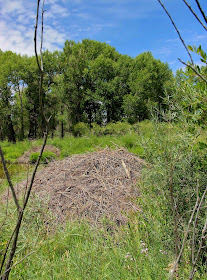This is the final post in a series about a recent trip through the “Heartland of Laramide Tectonics” in south central Wyoming. By definition, this a
folded land. It was deformed during the Laramide Orogeny, the period of mountain-building that created the Rocky Mountains. But when I left Alcova Reservoir and drove south, the landscape quickly changed from folded to flat.
 |
Alcova Reservoir is in a land of folds and faults.
|
 |
The scenery along the county road to the south is very different.
|
Occasionally there were curious granite hills and mountains sticking up above the rolling land. They didn’t look much like Laramide mountains, which are elongate ranges with upturned sedimentary rocks on the flanks. These were bare rounded granite outcrops of various shapes and sizes, with no obvious geologic structure.
 |
| “massive pink granite ... crops out in bald stark knobs that stand above the light colored, flat-lying sediments” -- D. Blackstone, 1988 |
This kind of scenery continued for miles and miles until I arrived at the north flank of the Seminoe Mountains -- steep, dark and ominous. It was hard to believe that the county road continued on, but it did! Here the North Platte River had cut into the surface I’d been driving on, revealing flat, undeformed rock strata. Aha! ... Tertiary fill!
 |
Informative exposure of nearly-flat pale Tertiary sediments, with North Platte River in foreground (bridge) and Seminoe Mountains behind.
|
“Tertiary fill” refers to sediments that were eroded off Laramide mountain ranges and deposited in adjacent basins. When the basins were filled, deposition continued onto the flanks of the ranges themselves. Eventually they were mostly buried, with just the highest peaks exposed (cross-section below).
[Note: The Tertiary Period has been replaced with two subunits -- Paleogene and Neogene -- but we still use “Tertiary fill” as it’s a useful descriptor.]
 |
Laramide uplifts were eroded and largely buried in Tertiary fill (yellow). Block diagrams by B Mears, Jr, from originals by SH Knight (Regional Geomorphology class, University of Wyoming, 1984).
|
Then came the Great Exhumation (Snoke 1993) -- a time of widespread erosion. Much of the Tertiary fill was removed, uncovering the old landscapes. Why this happened isn't clear. Perhaps regional uplift increased erosive power of streams, or maybe climate change brought more rain and more erosion. Whatever the cause, exhumation was followed by yet another depositional phase (burial), and then another period of erosion (exhumation) to produce today’s great Laramide scenery.
 |
| For reasons still debated, the old landscapes were exhumed ... |
 |
| ... and then buried again ... |
 |
| ... and then re-exhumed to produce today's Wyoming landscapes. |
Turns out I had just driven across some of the best preserved Tertiary fill in Wyoming. But why wasn’t it removed during the Great Exhumations? And is there something still buried down there? Here are some clues as to what that might be:
-- Tertiary fill laps directly onto clusters of Precambrian granite outcrops.
-- Boulders of the same Precambrian granite have been found on summits of mountains a short distance south, at higher elevations.
-- Normal faults bound the area on the north and south (click on map to view).
 |
Neogene normal faults in Wyoming (Flanagan & Montagne 1993), with Granite Mountains labeled in red.
|
Buried in the Tertiary fill are the remains of a Laramide uplift! These are the Granite Mountains, the most mysterious mountains in Wyoming. They were once a typical Laramide uplift, but then the core collapsed and the crest ended up
below the flanks. The down-dropped block is bounded on the north and south by normal faults, forming a
graben. Displacement is estimated to be 2000 feet. Because the block subsided significantly, much of the Tertiary fill has been preserved, with only the highest peaks of the old range exposed. So this is a remnant of Wyoming landscapes prior to the Great Exhumations (block diagrams 1. and 3. above).
 |
A bit of the Really Old West: high peaks of the Granite Mountains rise above Tertiary fill. These are the Pedro Mountains -- the east end of the old range.
|
 |
Cross-section through the Sweetwater graben (Mears et al. 1986); click on image to view.
|
Only the core of the Granite Mountains collapsed; the flanks remained in place. These are now represented by the Rattlesnake Hills on the north side of the graben, and the Seminoe, Ferris, Green and Crooks mountains to the south. On the summits of Green and Crooks mountains are granite boulders eroded off the high peaks before they were down-dropped. In other words, the boulders now lie higher than their source.
 |
South side of Seminoe Mountains in distance, with steeply-dipping sedimentary strata. They were part of the south flank of the Granite Mountains before the core collapsed.
|
 |
| Dark foreboding metamorphic rocks on the north side of the Seminoes, exposed by normal faulting. |
The normal faults of the Granite Mountains are fairly recent. Flanagan and Montagne (1993) dated them to about 11 million years ago, at least 30 million years after Laramide uplift ceased. The cause is debated. Normal faults generally are associated with crustal extension, yet there’s no clear link between normal faulting in Wyoming and the major episodes of Tertiary extension in western North America -- Basin and Range province and Rio Grande Rift. So “anomalous” is what it’s called for now (Snoke 1993).
The Sweetwater River flows though the graben from west to east, through the old high peaks of the Granite Mountains. This was the route of the Oregon and Mormon Trails, traveled by many thousands of pioneers headed west to better lives. About 50,000 passed in 1847 alone (Blackstone 1988). The granite outcrops became landmarks -- Devils Gate, Split Rock, Independence Rock.
 |
"Independence Rock" by WH Jackson. Split Rock is in distance. Source.
|
 |
“Camp of the US Geological Survey" in the Sweetwater graben; by WH Jackson, 1870. Source.
|
 |
| "The Emigrant's Grave" along the Sweetwater River; by WH Jackson, 1870. Source. |
Sources
Blackstone, DL, Jr. 1988. Traveler’s guide to the geology of Wyoming, 2nd ed. Geological Survey of Wyoming Bulletin 67. Laramie, WY.
Flanagan, KM and Montagne, J. 1993. Neogene stratigraphy and tectonics of Wyoming, in Snoke, AW, Steidtmann, JR, and Roberts, SM, eds. Geology of Wyoming. Wyoming State Geological Survey Memoir 5:572-607. Laramie, WY.
Mears, B, Jr, Eckerle, WP, Gilmer, DR, Gubbels, TL, Huckleberry, GA, Marriott, HJ, Schmidt, KJ and Yose, LA. 1986. A geologic tour of Wyoming from Laramie to Lander, Jackson and Rock Springs. Geological Survey of Wyoming Public Information Cirucular No. 27. Laramie, WY.
Snoke, AW 1993. Geologic history of Wyoming within the tectonic framework of the North American Cordillera, in Snoke, AW, Steidtmann, JR, and Roberts, SM, eds. Geology of Wyoming. Wyoming State Geological Survey Memoir 5:2-56. Laramie, WY.



























































